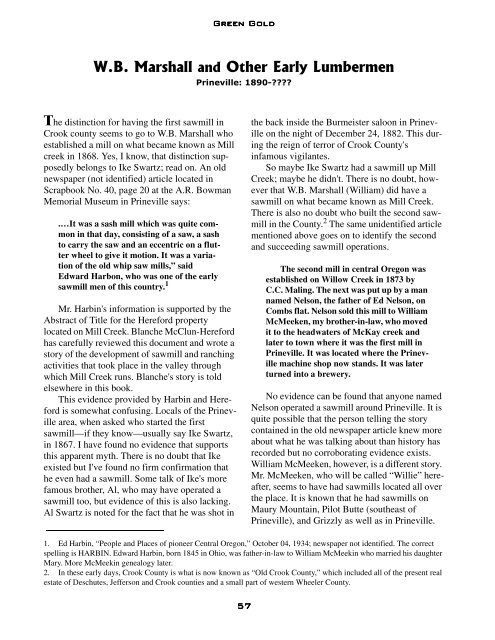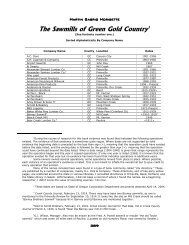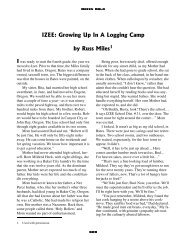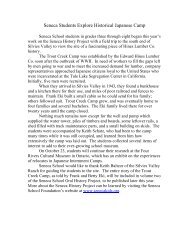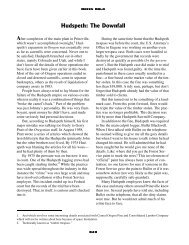09-WB Marshall.pdf - The Seneca School Foundation
09-WB Marshall.pdf - The Seneca School Foundation
09-WB Marshall.pdf - The Seneca School Foundation
You also want an ePaper? Increase the reach of your titles
YUMPU automatically turns print PDFs into web optimized ePapers that Google loves.
he distinction for having the first sawmill in<br />
Crook county seems to go to W.B. <strong>Marshall</strong> who<br />
established a mill on what became known as Mill<br />
creek in 1868. Yes, I know, that distinction supposedly<br />
belongs to Ike Swartz; read on. An old<br />
newspaper (not identified) article located in<br />
Scrapbook No. 40, page 20 at the A.R. Bowman<br />
Memorial Museum in Prineville says:<br />
.…It was a sash mill which was quite common<br />
in that day, consisting of a saw, a sash<br />
to carry the saw and an eccentric on a flutter<br />
wheel to give it motion. It was a variation<br />
of the old whip saw mills,” said<br />
Edward Harbon, who was one of the early<br />
sawmill men of this country. 1<br />
Mr. Harbin's information is supported by the<br />
Abstract of Title for the Hereford property<br />
located on Mill Creek. Blanche McClun-Hereford<br />
has carefully reviewed this document and wrote a<br />
story of the development of sawmill and ranching<br />
activities that took place in the valley through<br />
which Mill Creek runs. Blanche's story is told<br />
elsewhere in this book.<br />
This evidence provided by Harbin and Hereford<br />
is somewhat confusing. Locals of the Prineville<br />
area, when asked who started the first<br />
sawmill—if they know—usually say Ike Swartz,<br />
in 1867. I have found no evidence that supports<br />
this apparent myth. <strong>The</strong>re is no doubt that Ike<br />
existed but I've found no firm confirmation that<br />
he even had a sawmill. Some talk of Ike's more<br />
famous brother, Al, who may have operated a<br />
sawmill too, but evidence of this is also lacking.<br />
Al Swartz is noted for the fact that he was shot in<br />
the back inside the Burmeister saloon in Prineville<br />
on the night of December 24, 1882. This during<br />
the reign of terror of Crook County's<br />
infamous vigilantes.<br />
So maybe Ike Swartz had a sawmill up Mill<br />
Creek; maybe he didn't. <strong>The</strong>re is no doubt, however<br />
that W.B. <strong>Marshall</strong> (William) did have a<br />
sawmill on what became known as Mill Creek.<br />
<strong>The</strong>re is also no doubt who built the second sawmill<br />
in the County. 2 <strong>The</strong> same unidentified article<br />
mentioned above goes on to identify the second<br />
and succeeding sawmill operations.<br />
<strong>The</strong> second mill in central Oregon was<br />
established on Willow Creek in 1873 by<br />
C.C. Maling. <strong>The</strong> next was put up by a man<br />
named Nelson, the father of Ed Nelson, on<br />
Combs flat. Nelson sold this mill to William<br />
McMeeken, my brother-in-law, who moved<br />
it to the headwaters of McKay creek and<br />
later to town where it was the first mill in<br />
Prineville. It was located where the Prineville<br />
machine shop now stands. It was later<br />
turned into a brewery.<br />
No evidence can be found that anyone named<br />
Nelson operated a sawmill around Prineville. It is<br />
quite possible that the person telling the story<br />
contained in the old newspaper article knew more<br />
about what he was talking about than history has<br />
recorded but no corroborating evidence exists.<br />
William McMeeken, however, is a different story.<br />
Mr. McMeeken, who will be called “Willie” hereafter,<br />
seems to have had sawmills located all over<br />
the place. It is known that he had sawmills on<br />
Maury Mountain, Pilot Butte (southeast of<br />
Prineville), and Grizzly as well as in Prineville.<br />
1. Ed Harbin, “People and Places of pioneer Central Oregon,” October 04, 1934; newspaper not identified. <strong>The</strong> correct<br />
spelling is HARBIN. Edward Harbin, born 1845 in Ohio, was father-in-law to William McMeekin who married his daughter<br />
Mary. More McMeekin genealogy later.<br />
2. In these early days, Crook County is what is now known as “Old Crook County,” which included all of the present real<br />
estate of Deschutes, Jefferson and Crook counties and a small part of western Wheeler County.
Yet no other information—save some genealogical<br />
information ferreted by the ever-digging Don<br />
Houk who has found a lot about this industrious<br />
man—sees to exist. William McMeeken (sometimes<br />
spelled McMeekin and once even Mac-<br />
Meeken) remains a mystery. Here is what little<br />
I’ve been able to learn. 3<br />
William McMeekin's father and grandfather<br />
were both named William. <strong>The</strong> eldest William,<br />
born in 1804, married Nancy Jane Hale on May<br />
23, 1865—obviously not his first marriage. William<br />
the first's son, William II, born 1825, married<br />
Nancy Jane Baker on June 17, 1866, adding more<br />
confusion to the family tree.<br />
At the time of the 1900 census Willie was living<br />
next door to Sam Compton in the McKay precinct.<br />
By 1910, Willie now age 65, was living in<br />
the Joseph Smith household in the Willow Creek<br />
precinct. Willie's wife, Mary, had died in 19<strong>09</strong><br />
and left her entire estate to Al Cubitt who must<br />
have been a family friend. By the 1910 census,<br />
both Cubitt and McMeekin were living with<br />
Joseph Smith in the Willow Creek district.<br />
Mary's motives in leaving her estate to Al<br />
may have been this: William, at age 64, wouldn't<br />
be around much longer and probably needed care.<br />
That care may have been provided by Mr. Cubitt.<br />
<strong>The</strong> newspaper article continues:<br />
<strong>The</strong> first planing mill in Prineville was<br />
build in 1875 by John Hamilton on the corner<br />
which the Prineville creamery now<br />
occupies [southeast corner, North Beaver<br />
& West 4th streets]. Here was made the finishing<br />
lumber for the first courthouse and,<br />
the first schoolhouse as well as many other<br />
buildings. Hamilton sold this planing mill<br />
to Maling who later sold it to me. I<br />
took in John B. Shipp 4 as a partner<br />
and later sold my interest to<br />
him and started another. This second<br />
mill burned in 1878 and that<br />
closed my ventures in wood working<br />
shops. I had always worked in<br />
metal before coming here.<br />
<strong>The</strong> narrator of this story, now<br />
assumed to be Gardiner Perry, lived an<br />
interesting life and since these details are<br />
not preserved elsewhere and because the<br />
narrator was, although he didn't make<br />
such a claim, working in the timber<br />
industry they will be set forth here without<br />
further interruption.<br />
During the next few years I<br />
worked for others and for the<br />
county and built all the bridges<br />
put up in Crook county which<br />
included what is now Crook, Des-<br />
3. All of this is compliments of Don Houk and his extensive research into incomplete and inaccurate records. Don’s persistence<br />
paid off and I can now write what follows about Wm. McMeekin.<br />
4. This seems to suggest that the person telling the story is Gardiner Perry. Shipp & Perry were partners in business<br />
together as early as 1900. Known as Shipp & Perry, they were known to operate a saw mill and planing mill and were “manufacturers<br />
of lumber and shingles.” Additional information about the Shipp & Perry business will be provided elsewhere in<br />
this book.
chutes, Jefferson and a part of Wheeler<br />
counties. Among these bridges were those<br />
at Trail crossing, the Crooked river bridge<br />
near Prineville and the Mayfield bridge.<br />
Harold Baldwin and I took a contract<br />
to re-build the Tetherow bridge across the<br />
Deschutes and rode our bicycles back and<br />
forth to work. That was in 1896.<br />
<strong>The</strong> year of the famous smallpox epidemic<br />
in Prineville was a year of high<br />
water. W.A. Booth was county judge. He<br />
sent me down to look at the Crooked river<br />
bridge at the foot of the grade. <strong>The</strong> water<br />
was high and the bank was washing badly.<br />
A man with a team from Silver Lake came<br />
along and I would not let him pass over the<br />
bridge. He was anxious to get on his way<br />
and came back to town to see Judge Booth.<br />
<strong>The</strong> judge came with him to the bridge. He<br />
talked to me and I told him that I would<br />
not let the man pass but that he could do so<br />
if he wished. <strong>The</strong> judge finally gave his consent<br />
and the man passed safely over. He<br />
had not gone a hundred yards from the<br />
bridge when it went into the flood.<br />
Judge Booth gave me an order to<br />
replace the bridge as quickly as possible. I<br />
got a crew of men and went to Mill creek<br />
and hewed out two timbers for stringers.<br />
We loaded them on wagons and brought<br />
them to town. In just a week we had the<br />
bridge so people could cross. <strong>The</strong>n the<br />
smallpox epidemic broke out and I was<br />
practically the only man in town who was<br />
immune. I had a slight variloid [it is not<br />
known what this word should be]. Judge<br />
Booth put me […words unreadable on<br />
microfilm…] the washout had taken the<br />
bridge and 100 yards of the road. I could<br />
see no way to make the bridge connect the<br />
two ends of the road. Hirman Gobson<br />
owned the land at the bridge. He was mad<br />
at the court and refused to sell to them. But<br />
he sold me a right-of-way 45 feet wide for<br />
$25 and by giving him my personal check<br />
for the land I got the two ends of the road<br />
joined with a 30-foot bridge.<br />
<strong>The</strong>re was a washout on the big flat<br />
between Cold Springs and Camp creek 35<br />
feet wide and ten feet deep. I drove piling in<br />
this place and made a bridge. <strong>The</strong>n I went<br />
on to the Hackleman place and put a<br />
bridge over Camp creek. For all these<br />
bridges I got my timber from the woods.<br />
<strong>The</strong> piling, capping and stringers were of<br />
tamarack. <strong>The</strong> county furnished the decking<br />
but all other timbers had to be sawed or<br />
hewed. <strong>The</strong> capping was sawed with a<br />
whipsaw.<br />
In addition to these bridges I repaired<br />
the bridge at the Percy Davis place at the<br />
forks of Crooked river. All this was done in<br />
one summer and the cost to the county was<br />
about $1500. I got out my own timbers,<br />
paid the wages of the men whom I hired<br />
nearest the job, and boarded the men. <strong>The</strong><br />
best wages paid was $1.50 per day. I got all<br />
supplies from the ranchers. Eggs were 10<br />
cents a dozen. Beef and flour were cheap.<br />
It was the first time that bridge work<br />
had been handled in this way and the men<br />
who worked for me were pleased to get my<br />
checks. I had arranged with Tom Baldwin<br />
[president of the bank] to take them up.<br />
<strong>The</strong>y did not like to be paid in county warrants.<br />
When court met and I told Judge Bell<br />
of the action I had taken in buying the<br />
right-of-way at Cold Springs, he laughed<br />
and said it was an unusual way of doing<br />
things, but that it was good enough. <strong>The</strong><br />
court approved my action.<br />
During the entire summer I had not<br />
come to town and had not seen a member<br />
of the court.<strong>The</strong>re were no telephones.<br />
I first came to Prineville in 1873. I<br />
made several trips here. In 1878 I brought<br />
my mother here. Dr. Belknap had just<br />
returned from medical school. We are the<br />
pioneers of Prineville business.No one else<br />
who was in business here then is now in<br />
business.<br />
I started a machine shop in 1904 5 and<br />
have been at this same location ever since.<br />
During all the years that I have lived in<br />
Prineville I have had some sort of a shop. I<br />
began with a cabinet shop.<br />
Other early sawmills include Prineville Lumber<br />
Company (1890), Providence Sawmill<br />
(1892), C.D. Calbreath Woodsawing Plant (1908)<br />
and others. <strong>The</strong>se operation are not described
ecause I have found no information about them.<br />
<strong>The</strong>y appear only in the list of sawmills. But this<br />
chapter is supposed to be about W. B. <strong>Marshall</strong>,<br />
so back to him.<br />
Very little is known about the man. He<br />
appears to have been unmarried, at least when he<br />
mortgaged his land in 1889 and again in 1891<br />
when he received a plot of public land from President<br />
Benjamin Harrison. 6 <strong>The</strong> best information<br />
on <strong>Marshall</strong> comes from Blanche McClun-Hereford's<br />
account of timber and ranching activities in<br />
the Mill Creek Valley. Although Blanche's article<br />
appears elsewhere in this book, the portion about<br />
<strong>Marshall</strong> is presented again here:<br />
William B. <strong>Marshall</strong>, a single man, was<br />
the first one to live on this place at the foot<br />
of Steen Pillar. He filed on a 160 acre homestead<br />
in 1888. He planted a large orchard<br />
and some of the trees are still bearing fruit.<br />
<strong>The</strong> orchard is a lot smaller now as a lot of<br />
the trees have died and have been removed.<br />
<strong>The</strong> old Mill Creek road used to go right in<br />
front of our house and the orchard was just<br />
above the road. <strong>The</strong> new Mill Creek road,<br />
which was built in 1950, goes above the<br />
orchard. Mr. <strong>Marshall</strong> had a lot of goats<br />
and they were often seen around and on top<br />
of the middle rock. <strong>The</strong> old timers named<br />
the middle rock Goat Rock. Goat Springs, I<br />
think, was also named for Mr.<strong>Marshall</strong>'s<br />
goats.<br />
<strong>Marshall</strong> borrowed money to build a<br />
sawmill which stood just below my house.<br />
This was a pen stock water-powered mill<br />
and could only run when there was ample<br />
water in the creek. <strong>The</strong> saw had only eight<br />
teeth. Mr. Compton soon bought in with<br />
<strong>Marshall</strong>, but they lost both land and mill.<br />
It was sold at public auction to satisfy <strong>Marshall</strong>'s<br />
note. John Combs bought it and sold<br />
land and mill 7 to John Demaris in 1895.<br />
John Demaris, who was my husband's<br />
great uncle, took a 160-acre homestead of<br />
1895. Soon Henry Birdsong bought in and<br />
they became partners in the mill.…<br />
This financial difficulty was a problem not<br />
only for <strong>Marshall</strong> but also for his young partner,<br />
Sam Compton (Sam's story is told elsewhere in<br />
this book). This may have been the end of <strong>Marshall</strong><br />
as a sawmill operator but not so Compton.<br />
Nothing beyond the 1887 advertisement included<br />
here has been found about Mr. <strong>Marshall</strong>.<br />
<strong>Marshall</strong> called his operation “Mill Creek<br />
Sawmill.” That name was used by others which<br />
makes tracking the ownership of <strong>Marshall</strong>'s operation<br />
difficult.<br />
5. This is probably the same location that was eventually owned by the Hudspeth family. <strong>The</strong> business was then called<br />
Prineville Machine Shop.<br />
6. Patent dated October 2, 1891, filed June 2, 1908, recorded in Vol. 3, Patents at page 514, Crook County Clerk’s Office.<br />
7. Mortgage, dated and filed December 19, 1889; recorded Vol. 1 Mortgages at page 737. <strong>The</strong> amount of the mortgage was<br />
$626.50. A marginal note on the mortgage reads, “Foreclosed May 8, 1893; Journal 2, Page 566.”
An advertisement for <strong>Marshall</strong>’s mill on<br />
Mill creek appears on the previous page. I<br />
failed to note the date on which it appeared.<br />
<strong>The</strong> next chapter is about a Wheeler<br />
County sawmill operator, N.S. Nelson and<br />
unlike the sketchy information for <strong>Marshall</strong>,<br />
Nelson’s operation is well documented.<br />
Cleanup at Hudspeth<br />
got a little too hot this<br />
day and melted some<br />
of the Wigwam burner.<br />
I’ve talked with the<br />
man responsible but I<br />
don’t remember the<br />
date.
Consolidated Pine, Inc.; date unknown. Photo by Western Ways, Inc. of Corvallis, Oregon. Western Ways<br />
is no longer in business. Some years ago, a contact of mine—another history buff—Steve Stone,<br />
acquired a large inventory of the company’s film negatives. Curt Deatherage scanned many of these<br />
negatives for Steve and provided me copies of those of timber industry operations in Green Gold Country.


